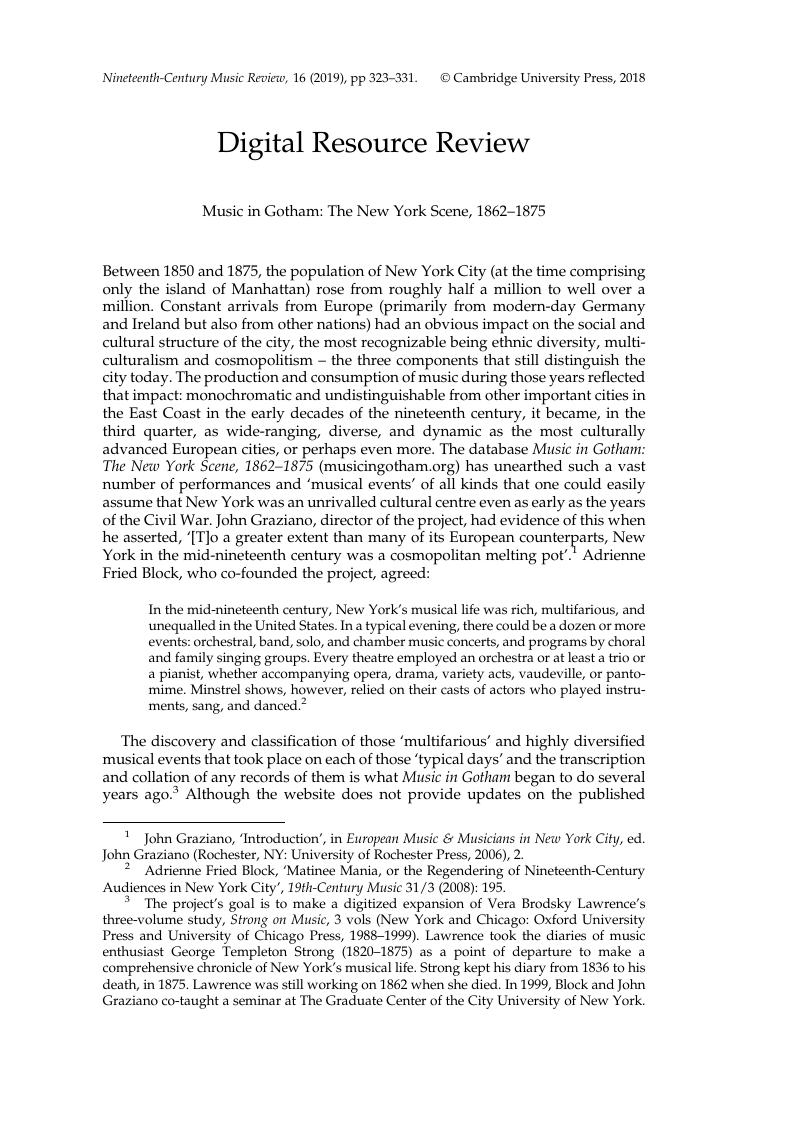No CrossRef data available.
Article contents
Music in Gotham: The New York Scene, 1862–1875
Published online by Cambridge University Press: 02 November 2018
Abstract

- Type
- Digital Resource Review
- Information
- Copyright
- Copyright © Cambridge University Press, 2018
References
1 Graziano, John, ‘Introduction’, in European Music & Musicians in New York City, ed. John Graziano (Rochester, NY: University of Rochester Press, 2006), 2Google Scholar.
2 Block, Adrienne Fried, ‘Matinee Mania, or the Regendering of Nineteenth-Century Audiences in New York City’, 19th-Century Music 31/3 (2008): 195Google Scholar.
3 The project’s goal is to make a digitized expansion of Vera Brodsky Lawrence’s three-volume study, Strong on Music, 3 vols (New York and Chicago: Oxford University Press and University of Chicago Press, 1988–1999). Lawrence took the diaries of music enthusiast George Templeton Strong (1820–1875) as a point of departure to make a comprehensive chronicle of New York’s musical life. Strong kept his diary from 1836 to his death, in 1875. Lawrence was still working on 1862 when she died. In 1999, Block and John Graziano co-taught a seminar at The Graduate Center of the City University of New York. Students were required to create a chronology of all the musical events listed in articles, reviews, announcements and advertisements in daily newspapers starting with the last year that Lawrence completed. I was in fact one of those students – my assigned chronology corresponded to the 1874–75 season. After receiving funding from the National Endowment for the Arts (2001) and the Baisley Powell Elebash Endowment, the results of the seminar were developed and transformed into the Music in Gotham project. The initial chronologies were expanded and the data library systematised, eventually leading to the creation of the current internet database. After Block’s death in 2009, John Graziano and other scholars, including, among others, Ruth Henderson, Roberta Graziano, Danielle Bastone and Jennifer C. H. J. Wilson, continued enlarging and editing the database.
4 The last published record is a variety performance at the French Theatre (Théâtre français, located on Fourteenth Street, west of Sixth Avenue) that took place on 28 May 1868.
5 In terms of population, New York City was the third-largest ‘German city’ (after Berlin and Vienna). See Koegel, John, Music in German Immigrant Theater. New York City, 1840–1940 (Rochester, NY: University of Rochester Press, 2009), 2Google Scholar. In the years covered by Music in Gotham, there were six German theatres operating in Little Germany. One of them was the Stadttheater, at 37–39 Bowery, site of the first performance of Wagner’s Tannhäuser outside the German Estates or the Austro-Hungarian Empire, in 1859 (thus preceding the notorious Parisian premiere by two years).




